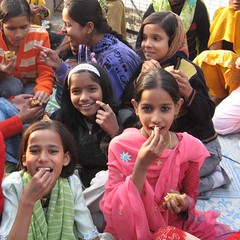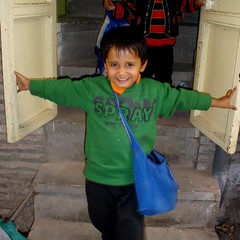
by Anuradha Bakshi | Feb 6, 2009 | Uncategorized
 What is your one single special wish was the question asked by a visiting friend to a bunch of teenage girls at our women centre. The question was met with stony silence and a few quizzical glares. Children from slums are rarely asked what their wishes are. But all children have dreams and aspirations. It was time to try and ferret them out.
What is your one single special wish was the question asked by a visiting friend to a bunch of teenage girls at our women centre. The question was met with stony silence and a few quizzical glares. Children from slums are rarely asked what their wishes are. But all children have dreams and aspirations. It was time to try and ferret them out.
D, our committed coordinator decided to rephrase the question: if you had 1000 Rs what would you get. And out came the answers: a watch, a tape recorder, clothes, school books, gifts for my siblings, a new school bag, clips for my hair and more. Simple dreams, simple desires that reflected the small things that we take for granted but that hold such meaning for these kids. None costing anything close to the 1000 imaginary rupees, and yet things that were so dear to these young girls. The answers were moving in their simplicity.
We decided to delve deeper and asked what they would like to change around them if they could and pat came the answers: get rid of the dirt and garbage around us, get clean water, plant more trees and so on. One young girl simply said she wanted people to learn to respect others. The reason for this was touching: she has no father and her mother works but is often the butt of nasty and misplaced comments. She just wanted others to respect her mom.
Children have wisdom beyond their age but sadly cannot always express their views or share their opinions. No one is willing to listen to them.
A day earlier the same friend had asked the same question to our special kids, the ones many think have no dreams. This is what they said: Radha who can never walk wants to be a dancer. Ankur a policeman, Anurag simply wants to become a big man and Preeti a teacher. Dreams that may seem impossible but are nevertheless important to these children of a lesser God. No dream is ever too small, no dream is ever too big…
by Anuradha Bakshi | Feb 4, 2009 | Uncategorized
How long will it take for little Komal’s scars to heal. I am not talking about the bruises and lesions but of the scars now seared on a little six year old’ s soul. Komal was mercilessly and brutally beaten by sadistic and sick cops in a small town of Uttar Pradesh. Her crime: 200 rs stolen from a woman who thought her to be the culprit. Komal was beaten in public by a policeman while many watched. Her heart rendering cries and pleas fell on deaf years. Actually everyone seemed to be enjoying the show not realising that the camera was rolling.
Her crime was that she belonged to the poorest of the poor, the lowest of the low, those who often become the butt of many a vile game. And this is no isolated incident. The poor and voiceless are subjected to such brutality day in and day out.
The images played out yesterday are disturbing in more ways than one. The despair of the tiny girl in her long skirt and bare feet, screaming and pleading is disturbing indeed but what was more frightening was the look of sadistic pleasure on the faces of the perpetrators, what was more disturbing was the smiles and sneers and the total absence of sensitivity of those looking on.
Komal’s horrific story is the talk of the day as is always the case. Debates are aired on every channel. In one such debate a retired police officer mentioned the fact that policemen were harassed, stressed and overworked and thus vented their frustration. I would like to ask the person whether the same cop would vent his so called frustration on his own 6 year old. There was talk of the need of reforms and more stringent laws. But a juvenile justice act exists which did protect this child if it had been applied.
Had the cameras not been there was the tag line used by one of the TV channels and one really wonders what would have happened to little Komal had the cameras not been there. How long would it have taken for the sadistic cop to vent his so called frustration or how long would the onlookers have enjoyed the show. What is disturbing is that each and every time an aberration like this occurs in full public view, no one reaches out to help the victim. Wonder why?
But the cameras were rolling and Komal’s story was for all to see. Since then a huge damage control drama is in operation: the cops have surrendered, one is in jail the other on bail. Komal’s family was visited by senior police officers who proffered apologies, police stations will be informed about the right of children and so on. But will all this heal the scars of the soul of little Komal. And above all will cameras be rolling the next time another Komal is brutalised.
There are more questions that need to be asked. When will we as a civil society cease to be mute spectators? When will we stop pointing fingers at the weak, the voiceless and the poor each time a petty crime is committed? Will the woman who falsely accused little Komal be made accountable? And will the perpetrator of this heinous abuse be truly punished?

by Anuradha Bakshi | Feb 1, 2009 | Uncategorized
 Little D has been rejected by 18 schools. He is just three and was one of the 400 000 aspirants to the 200 000 seats in nurseries run by coveted schools. So even with my poor math 200 000 kids are left in the lurch having failed to meet the requirements of the complicated and ambiguous point system.
Little D has been rejected by 18 schools. He is just three and was one of the 400 000 aspirants to the 200 000 seats in nurseries run by coveted schools. So even with my poor math 200 000 kids are left in the lurch having failed to meet the requirements of the complicated and ambiguous point system.
Let me elucidate. Little D applied to a neighborhood school thus getting the proximity to school points. But that is where it stops he cannot get the 5 points he would have got were his parents alumni of the school – they belong to another city – or the 2o if he had a sibling in school – he is the first child- , or the 5 if he was a girl child – he is a boy – or the whopping 20 were his parents post graduates – his family is one of first generation learners who want to give the best to their child.
The point system is needless to say elitist, even though it pretends to be fair and transparent. Fees charged by private schools are indeed a deterrent but even if a first generation learner parent managed to surmount this obstacle, the point system ensures that he will be weeded out sooner than later. The caste system pervades insidiously and surreptitiously and we will keep the status quo. Good schools for kids with sparkling pedigrees, the others relegated to the squalor of municipal schools by force majeure. Yes how can little D produce a masters degree for his parents and even if he did how could they manage to fill the long questionnaire akin to an exam paper or answer the questions fired to them in a language they do not master. The Ganguly 100 pint system is a clever ploy to preserve the prerogative of the upper classes. Schools in India have a long way to go before they become level playing grounds for all the children of India, you know the ones who have a constitutional right to free education of equitable quality!
So where does D go from here, or where do the 200 000 rejected children go. To private nursery schools I guess till next year when they will need to get admissions in class I. But these classes will already be filled with the school’s nursery kids. True there are lesser schools, those that have not yet become famous and then there are the state run schools both by the municipal corporation and the state administration the later a little better than the former. But as things stand this is not yet an option for the parents of the 200 000 kids. I say not yet because the day is not far when they may just have to become the only viable alternative or so one would want: a common school that offers free and equitable education for all. True that the road will be long and the detractors many, and true again that the state run schools will need to be revamped and restyled. Let us go back a few years, oh not so very long ago, to the days when public schools were few and many children from the middle class went to government schools. Peruse the bio data of present and past senior government officers, bankers and other well placed people and you will see that they are often product of government schools. So why can this not happen again.
Today the obsession of sending your child to a English Medium Public School has percolated to the lowest classes of society. Yet it was music to my years to hear some parents mention on the various debate on admission aired on every channel the word government school. True that everyone felt they were not an option as the were poorly run, but somehow one felt that if they were made better parents would consider it an option. So why can’t we? Maybe because there are many forces who do not want this to happen, but that is another debate. The reality is that as I write these words is that 200 000 kids have been rejected and have nowhere to go!

 What is your one single special wish was the question asked by a visiting friend to a bunch of teenage girls at our women centre. The question was met with stony silence and a few quizzical glares. Children from slums are rarely asked what their wishes are. But all children have dreams and aspirations. It was time to try and ferret them out.
What is your one single special wish was the question asked by a visiting friend to a bunch of teenage girls at our women centre. The question was met with stony silence and a few quizzical glares. Children from slums are rarely asked what their wishes are. But all children have dreams and aspirations. It was time to try and ferret them out.

